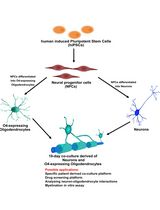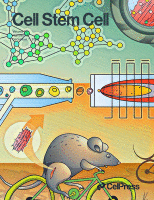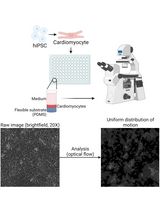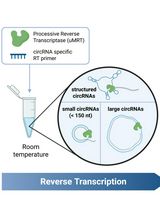- EN - English
- CN - 中文
Automated 384-well SYBR Green Expression Array for Optimization of Human Induced Pluripotent Stem Cell Differentiation
用于优化人诱导多能干细胞分化的自动化384孔SYBR绿色表达阵列
发布: 2023年06月05日第13卷第11期 DOI: 10.21769/BioProtoc.4689 浏览次数: 1849
评审: Xi FengSubhra Prakash HuiLei GaoAnonymous reviewer(s)

相关实验方案

人 iPSC 衍生神经元与少突胶质细胞共培养用于髓鞘形成的小分子筛选分析
Stefanie Elke Chie [...] Maria Consolata Miletta
2025年05月05日 2676 阅读
Abstract
Cell populations and tissues exhibit unique gene expression profiles, which allow for characterizing and distinguishing cellular subtypes. Monitoring gene expression of cell type–specific markers can indicate cell status such as proliferation, stress, quiescence, or maturation. Quantitative reverse transcriptase PCR (qRT-PCR) allows quantifying RNA expression of cell type–specific markers and distinguishing one cell type from another. However, qRT-PCR methods such as TaqMan technology require fluorescent reporters to characterize target genes and are challenging to scale up as they need different probes for each reaction. Bulk or single-cell RNA transcriptomics is time-consuming and expensive. Processing RNA sequencing data can take several weeks, which is not optimal for quality control and monitoring gene expression, e.g., during a differentiation paradigm of induced pluripotent stem cells (iPSCs) into a specialized cell type.
A more cost-effective assay is based on SYBR Green technology. SYBR Green is a nucleic acid dye that binds to double-stranded DNA, absorbs blue light at 497 nm, and emits green light at 520 nm up to 1,000-fold upon intercalation with double-stranded DNA. Amplification of a region of interest can be quantified based on the level of fluorescence intensity when normalized to a housekeeping gene and compared to control conditions. Previously, we established a SYBR Green qRT-PCR protocol to characterize samples using a limited set of markers plated on a 96-well plate.
Here, we optimize the process and increase throughput to a 384-well format and compare mRNA expression to distinguish iPSC-derived neuronal subtypes from each other by increasing the number of genes, cell types, and differentiation time points. In this protocol, we develop the following: i) using the command-line version of Primer3 software, we design primers more easily and quickly for the gene of interest; ii) using a 384-well plate format, electronic multichannel pipettes, and pipetting robots, we analyze four times more genes on a single plate while using the same volume of reagents as in a 96-well plate. The advantages of this protocol are the increased throughput of this SYBR Green assay while limiting pipetting errors/inconsistencies, reagent use, cost, and time.
Graphical overview

Figure 1. Overall optimized SYBR Green qRT-PCR workflow. (A) Primers are designed through the command-line version of Primer3. The program takes a couple of files as arguments: 1) an input file containing a sequence of the region of interest and a target, and 2) settings file with custom settings and primer picking conditions. The results are saved to a text file, checked for secondary and tertiary structures, then synthesized. (B) Primers are then plated using either multichannel pipettes with a pipetting aid or an automated pipetting robot. Plates are left to dry at room temperature and can be stored for an indefinite time. (C) Meanwhile, RNA is extracted from cell samples, reverse-transcribed into cDNA, then plated onto pre-coated 384-well plates. SYBR Green qRT-PCR is run and analyzed with QuantStudio software and Microsoft Excel.
Background
Quantitative reverse transcriptase PCR (qRT-PCR) is a fundamental laboratory technique to quantify the RNA gene expression of a biological sample. Previously, we developed a protocol that quantifies PCR products using an SYBR Green array in a 96-well format. SYBR Green is a dye that fluoresces when intercalated into double-stranded DNA (Srinivasaraghavan et al., 2022). As a region of interest is PCR-amplified, the amount of fluorescence is directly proportional to the amount of DNA content in the sample. This assay provides an accurate, cost-effective, and fast way to quantify the mRNA gene expression of a cell or tissue sample. Here, we optimized the throughput with a 384-well format, increasing the number of markers, simplifying and standardizing primer design, and automating pipetting of the plate to reduce manual pipetting errors and ensure volume accuracy. Each well uses 5 μL of reaction mix instead of the 20 μL in a 96-well plate, but the whole plate contains four times the number of wells. Thus, for the same volume of reagents used, one plate can output four times the data.
Scaling up the assay from 96- to 384-well plates requires optimization
However, qRT-PCR methods such as TaqMan technology require fluorescent reporters to characterize target genes and are challenging to scale up as they need different probes for each reaction. Bulk or single-cell RNA transcriptomics is time-consuming and expensive (Table 1). Processing RNA sequencing data can take several weeks, which is not optimal for monitoring gene expression, e.g., during a differentiation paradigm of induced pluripotent stem cells (iPSCs) into a specialized cell type. We improved primer design by using the command line version of Primer3 software. This avoids using the web interface, where user input errors can occur. Instead, the program uses 1) a text file containing all settings and primer conditions; 2) an input file containing the gene name, full gene sequence, and target region to amplify; and 3) an output file/folder containing compatible primers. Coating 384-well plates with primers is labor-intensive and yields potential user error. To mitigate this, we use one of three methods for plating primers: 1) use of a PlatR pipetting aid, which uses a tablet that lights up wells from underneath, 2) an E1-ClipTip adjustable tip-spacing electronic pipette, or 3) Integra ASSIST PLUS pipetting robot to pipette larger arrays with more plates. All three methods increase the throughput of generating coated plates and the consistency of volumes across all assays.
With the optimized format we describe in this protocol, we can assess 31 markers in triplicates on four samples on a single 384-well plate. Alternatively, 40 markers can be plated in triplicates on a plate with three samples. The number of wells needed for each will vary depending on the number of genes, replicates, and samples.
Human iPSC modeling
Patient-specific iPSC lines can be generated and differentiated to study cell processes, developmental defects, or disease mechanisms on a human genomic background. However, since differentiating these cells requires careful design of differentiation protocols, a method is needed to validate and confirm that this differentiation resembles that of in vivo tissue.
The use of many markers allows SYBR Green to be used to characterize many cell types. In contrast, the customizable plate allows flexible comparison of samples at different differentiation time points or between different cell types. Because most of the workflow for this SYBR Green protocol can be done within 1–2 days, the low turnaround time is ideal for characterizing cells at various time points during the differentiation process.
Optimization and validation of differentiation protocols using cell type–specific markers
The data analysis for RNA-seq methods can take some time and requires advanced bioinformatics tools. Our SYBR Green qRT-PCR gene expression can be completed in ~2 days, in which cells are harvested, cDNA synthesis is performed, and cDNA samples are quantified (Figure 1).
To show that the optimized primer design process can generate more markers and establish markers for optimizing current and future differentiation protocols, we have developed a library of markers to characterize multiple neuronal types at different developmental time points (Supplemental Table 1). This primer inventory includes cortical, striatal, and dopaminergic neurons and progenitors, pluripotency genes, astrocytes, hematopoietic precursors, microglia, retinal genes, synaptic markers, and germ layer markers.
Please note that we have saved Supplemental Table 1 and Supplemental Table 2 as individual files.
Table 1. Comparison between different RNA analysis tools
| Assay type | # of genes | Multiplexing | Approx. time | Cost |
|---|---|---|---|---|
| TaqMan | ~96 (4 samples) | 1–6 | ~1 day | $498/"scorecard" |
| Bulk RNA-seq | 300,000 | 1 | Weeks | $200–300 |
| scRNA-Seq | ~7–8,000 | Up to 8 | Weeks | ~$1,000 |
| SYBR Green | ~30 (4 samples) | 1–8 | ~1 day | ~$85/384-well plate |
Materials and reagents
MicroAmpTM Optical 384-well reaction plate (Applied Biosystems, catalog number: 4309849)
8-channel VOYAGER adjustable tip electronic pipette (Integra Biosciences, catalog number: 4721)
1.5 and 0.6 mL RNase-free microcentrifuge tubes
RNase-free filter pipette tips (P1000, P200, P20, and P2)
PowerUpTM SYBRTM Green Master Mix (Thermo Fisher, catalog number: A25742)
High-Capacity cDNA rev Transcription kit (Thermo Fisher, catalog number: 4368814)
DNase I, amplification grade (Invitrogen, Thermo Fisher Scientific, catalog number: 18068015)
PurelinkTM RNA Mini kit (Invitrogen, catalog number: 12183018A)
Homogenizer (Invitrogen, catalog number: 12183026)
2-mercaptoethanol (Aldrich Chemistry, Sigma-Aldrich, catalog number: M2650)
Nuclease-free water
Phosphate buffered saline without calcium and magnesium (PBS) (Thermo Fisher, catalog number: 70-011-044)
Custom-designed forward and reverse primers diluted to 100 μM in nuclease-free water
Integra GRIPTIP 6000 for ASSIST PLUS (Integra Biosystems, catalog number: 6403)
Bucket with wet ice
Personal protective equipment (gloves, lab coat, goggles)
10% bleach for decontamination
Equipment
Microcentrifuge 5415C (Eppendorf, catalog number: M7282)
Refrigerated centrifuge (Beckman Coulter, catalog number: GS6 Allegra)
Mini centrifuge (Fisher Scientific, catalog number: 05-090-100)
MiniAmpTM thermal cycler (Applied Biosystems, Thermo Fisher, catalog number: A37834)
NanoDrop spectrophotometer (Thermo Fisher, catalog number: 13-400-525)
PlateR visual pipetting aid tablet (Biosistemika, catalog number: P-10)
QuantStudio 6 Flex Real-Time PCR system (Applied Biosystems, catalog number: 4485691)
Integra ASSIST PLUS pipetting robot (Integra Biosciences, catalog number: 4505)
E1-ClipTip 200 Bluetooth electronic single channel pipette (Thermo Fisher, catalog number: 4670020BT
E1-ClipTip 384 12.5 electronic adjustable tip-spacing multichannel pipette (Thermo Fisher, catalog number: 4672010BT)
Software
QuantStudio 6 and 7 Flex Real-Time PCR software v1.7.2 (Thermo Fisher, https://www.thermofisher.com/us/en/home/global/forms/life-science/quantstudio-6-7-flex-software.html)
Primer3 (Steve Rozen, Helen Skaletsky, Triinu Koressaar, Maido Remm, and Andreas Untergasser, https://github.com/primer3-org/primer3)
Beacon Designer (Premier Biosoft, http://www.premierbiosoft.com/qOligo/Oligo.jsp?PID=1)
In silico PCR prediction (UCSC Genome Browser, https://genome.ucsc.edu/cgi-bin/hgPcr)
UNAFold (Integrated DNA Technology, https://www.idtdna.com/UNAFold). Create an account to use the software.
Integra VIALAB automation software (Integra, https://www.integra-biosciences.com/united-states/en/pipetting-robots/assist-plus/download-vialab)
RStudio Desktop (RStudio, https://www.rstudio.com/products/rstudio/download/)
Procedure
文章信息
版权信息
© 2023 The Author(s); This is an open access article under the CC BY-NC license (https://creativecommons.org/licenses/by-nc/4.0/).
如何引用
Chen, M. Y., Heinrich, L., Zafar, F., Sedov, K. and Schuele, B. (2023). Automated 384-well SYBR Green Expression Array for Optimization of Human Induced Pluripotent Stem Cell Differentiation. Bio-protocol 13(11): e4689. DOI: 10.21769/BioProtoc.4689.
分类
干细胞 > 多能干细胞 > 细胞分化
分子生物学 > RNA > RNA 检测
您对这篇实验方法有问题吗?
在此处发布您的问题,我们将邀请本文作者来回答。同时,我们会将您的问题发布到Bio-protocol Exchange,以便寻求社区成员的帮助。
提问指南
+ 问题描述
写下详细的问题描述,包括所有有助于他人回答您问题的信息(例如实验过程、条件和相关图像等)。
Share
Bluesky
X
Copy link










